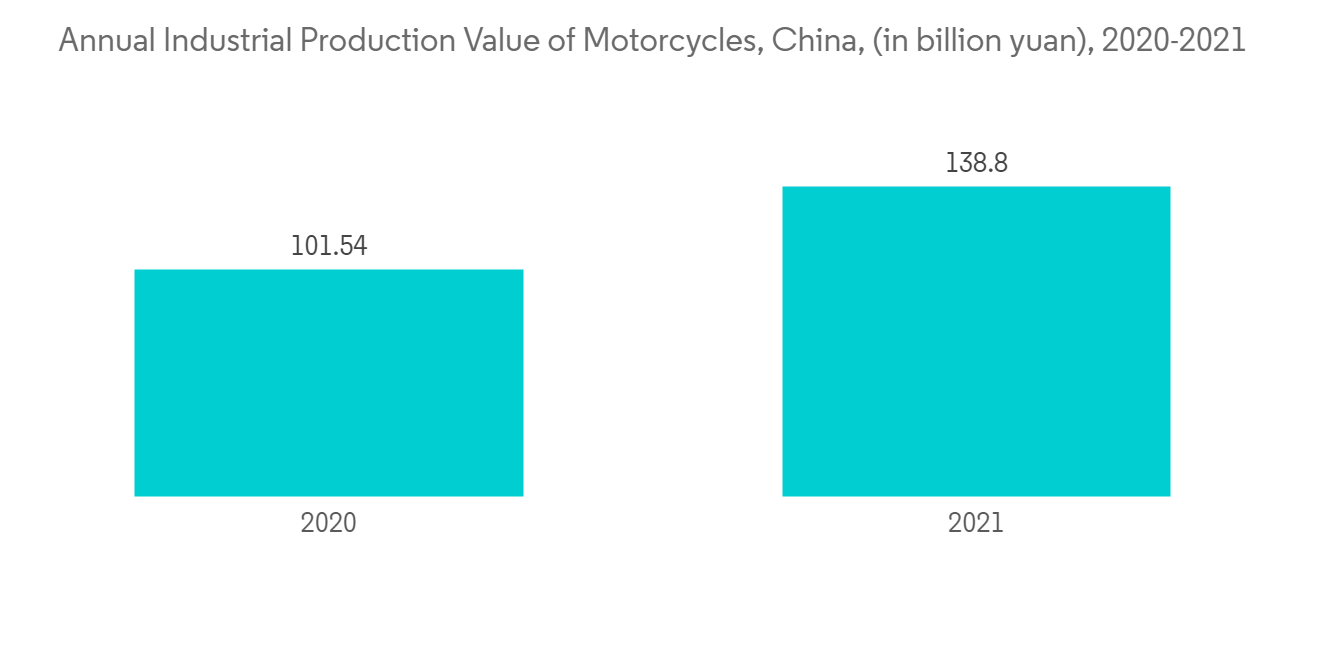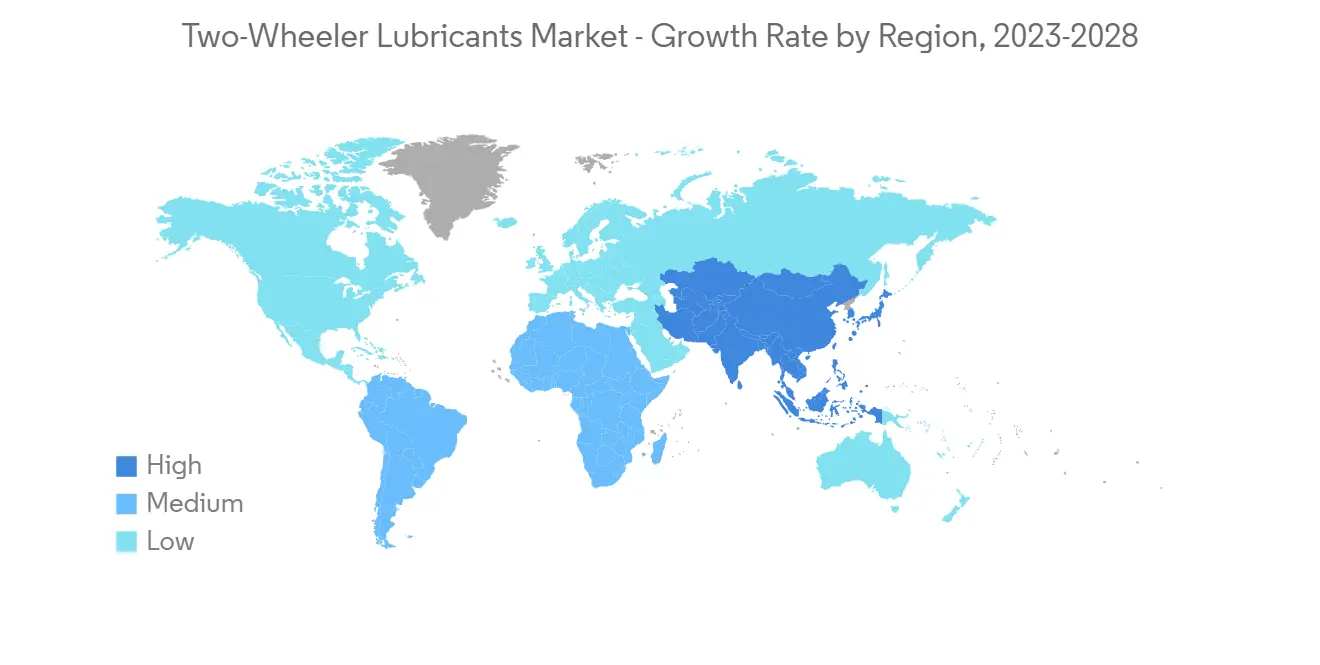 |
市场调查报告书
商品编码
1273500
摩托车润滑油市场 - 增长、趋势、COVID-19 的影响和预测 (2023-2028)Two-Wheeler Lubricants Market - Growth, Trends, and Forecasts (2023 - 2028) |
||||||
价格
※ 本网页内容可能与最新版本有所差异。详细情况请与我们联繫。
简介目录
摩托车润滑油市场预计在预测期内以超过 4% 的复合年增长率增长。
COVID-19 对 2020 年的市场产生了负面影响。 但目前估计已达到疫情前水平,市场有望稳步增长。
主要亮点
- 新兴国家/地区对机油的需求不断增长推动了市场增长
- 摩托车在印度和中国等国家/地区的销量增加预计将推动市场增长。
- 另一方面,电动汽车的普及可能会阻碍市场增长。
- 亚太地区主导着全球市场,其中中国、印度和日本等国家/地区的消费量最高。
摩托车润滑油市场趋势
机油用量增加
- 机油广泛用作摩托车内燃机的润滑剂。 它一般由基础油和添加剂组成。
- 基础油是使用石油、合成化学品或两者混合製成的。 基础油负责润滑发动机的运动部件并带走多余的热量。
- 添加到机油中的各种添加剂包括抗氧化添加剂、分散添加剂、清净添加剂、消泡添加剂、粘度指数调节剂、抗磨添加剂、腐蚀抑製剂、防冻添加剂、防冻添加剂等。 它控製油的粘度和润滑性,并保护髮动机零件免受磨损和损坏。
- 摩托车机油的主要功能是抗腐蚀和抗磨损。 延长发动机寿命和提高性能,减少摩擦,提高发动机性能,降低油耗,去除杂质和实现发动机清洁,优化发动机效率,通过优化冷却防止能量损失等。它会实现。
- 随着消费者可支配收入的增加,中国的两轮车行业正在显着扩张。 2021 年摩托车产值将达到约 1380 亿元人民币(201.2 亿美元),比 2020 年增长约 36%。 因此,我们积极支持市场的发展。
- 此外,中国的摩托车销量大幅增长。 例如,2021 年摩托车销售额将达到 1379.8 亿元人民币(201.2 亿美元),比 2020 年增长 36%。 因此,我们正在积极推动市场的增长。
- 因此,由于上述所有因素,预计机油使用量的增加将推动预测期内的市场增长。

亚太地区主导市场
- 在新兴国家/地区,对摩托车的需求正在显着增长。 亚太地区最近成为摩托车润滑油消费增长最快的地区。
- 城市化进程的加快、收入的增加、人口的增长以及摩托车製造商之间日益激烈的竞争正在为各个区域群体提供价格更优惠的车辆。
- 此外,孟加拉国、巴基斯坦、斯里兰卡和菲律宾等国家/地区对二手自行车的需求非常高。 然而,由于当地汽车组装的增加,预计未来十年新车销量将增加。
- 印度、马来西亚、新加坡、越南、孟加拉国和菲律宾等一些新兴国家/地区的摩托车润滑油消费量最近出现了正增长。
- 例如,2021 年,菲律宾的摩托车和踏板车销量将达到 1,435,677 辆,比 2020 年增长 19%。 在新加坡,摩托车和踏板车的销量在 2021 年增长了 8% 至 11,428 辆。 因此,它将积极支持市场的增长。
- 此外,马来西亚和菲律宾等国家/地区的摩托车和踏板车产量大幅增加。 例如,菲律宾2021年将生产867,453辆摩托车和踏板车,比2020年增长32%。 因此,我们正在积极推动市场的增长。
- 因此,由于上述发展,亚太地区有望在预测期内主导摩托车润滑油市场。

摩托车润滑油行业概况
- 摩托车润滑油市场本质上是分散的。 市场参与者包括 BP p.l.c.、Shell plc、PT Pertamina (Persero)、TotalEnergies 和 Idemitsu Kosan(排名不分先后)。
其他福利:
- Excel 格式的市场预测 (ME) 表
- 3 个月的分析师支持
内容
第一章介绍
- 调查先决条件
- 本次调查的范围
第二章研究方法论
第 3 章执行摘要
第四章市场动态
- 主持人
- 新兴国家/地区对机油的需求不断扩大
- 其他司机
- 约束因素
- 电动汽车的推广
- 其他抑製剂
- 工业价值链分析
- 波特的五力分析
- 供应商的议价能力
- 消费者的议价能力
- 新进入者的威胁
- 替代品的威胁
- 竞争程度
第 5 章市场细分
- 产品类型
- 机油
- 液压油
- 剎车油
- 链条油
- 最终用户行业
- 摩托车
- 滑板车
- 地区
- 亚太地区
- 中国
- 印度
- 日本
- 韩国
- 其他亚太地区
- 北美
- 美国
- 加拿大
- 墨西哥
- 北美其他地区
- 欧洲
- 德国
- 英国
- 意大利
- 法国
- 俄罗斯
- 其他欧洲
- 南美洲
- 巴西
- 阿根廷
- 其他南美洲
- 中东和非洲
- 沙特阿拉伯
- 南非
- 其他中东和非洲地区
- 亚太地区
第六章竞争格局
- 併购、合资、合作、合同等。
- 市场份额 (%)/排名分析
- 主要公司采用的策略
- 公司简介
- BP p.l.c.
- Chevron Corporation
- Exxon Mobil Corporation
- Hindustan Petroleum Corporation Limited
- Idemitsu Kosan Co., Ltd
- PT Pertamina(Persero)
- Petroliam Nasional Berhad(PETRONAS)
- Shell plc
- China Petrochemical Corporation
- TotalEnergies
第七章市场机会与未来趋势
简介目录
Product Code: 70901
The Two-Wheeler Lubricants Market is projected to register a CAGR of more than 4% during the forecast period. COVID-19 negatively impacted the market in 2020. However, the market is now estimated to have reached pre-pandemic levels and is expected to grow steadily.
Key Highlights
- Increasing demand for engine oils from developing countries is fuelling market growth.
- Increasing sales of motorcycles in countries such as India, China, etc., are expected to fuel the market's growth.
- On the other hand, the increasing penetration of electric vehicles is likely to hamper the market growth.
- The Asia-Pacific region dominated the global market, with the largest consumption from countries such as China, India, and Japan.
Two-Wheeler Lubricants Market Trends
Increasing Usage of Engine Oils
- Engine oils are widely used for lubricating internal combustion engines in two-wheelers. They are generally composed of base oils and additives.
- The base stock is made using petroleum, synthetic chemicals, or both. The base stock is responsible for lubricating the engine's moving parts and removing the excess built-up heat.
- Various additives added in engine oils include oxidation inhibitor additives, dispersant additives, detergent additives, anti-foaming additives, viscosity index modifiers, anti-wear additives, corrosion inhibitor additives, and anti-freeze additives. It controls the oil viscosity and lubricity and protects the engine parts against wear and tear.
- Some major functions of engine oils in two-wheelers are resistance against corrosion and wear and tear. It is to ensure increased engine life and better performance, reduction of friction, increase engine performance, reduction of fuel consumption, removal of impurities and achieve engine cleanliness, optimize engine efficiency, and prevent energy loss by providing optimum cooling.
- China's motorcycle sector is expanding significantly due to increasing consumer disposable income. Motorcycle production value totaled roughly CNY 138 billion (USD 20.12 billion) in 2021, representing an increase of around 36% compared to 2020. Hence, supporting the market growth positively.
- Moreover, the sales value of motorbikes in China also increased considerably. For instance, in 2021, the sales of motorcycles increased by 36%, amounting to CNY 137.98 billion (USD 20.12 billion) compared to 2020. As a result, positively boosts market growth.
- Thus, owing to all the factors above, increasing the use of engine oils is expected to fuel the market growth throughout the forecast period.

Asia-Pacific Region Dominates the Market
- The demand for two-wheelers in developing countries is growing vastly. Asia-Pacific recently became the fastest-growing region in the consumption of two-wheeler lubricants.
- Increasing urbanization, rising incomes, growing population, and progressive competition between two-wheeler manufacturers offer a better price on vehicles that various regional groups can afford.
- Moreover, Bangladesh, Pakistan, Sri Lanka, the Philippines, and other countries highly demand used bikes. However, the sale of new motor vehicles is expected to rise in the next ten years, owing to the increasing local assembly of motor vehicles.
- Some developing countries such as India, Malaysia, Singapore, Vietnam, Bangladesh, and the Philippines have recently witnessed positive growth in the consumption of two-wheeler lubricants.
- For instance, in 2021, the sales of motorcycles and scooters in the Philippines reached 1,435,677, representing a 19% increase compared to 2020. Also, in Singapore, sales of motorcycles and scooters increased by 8%, reaching 11,428 in 2021. Hence, supporting the market growth positively.
- Furthermore, in countries such as Malaysia, the Philippines, and others, the production of motorcycles and scooters increased significantly. For instance, the Philippines produced 867,453 motorcycles and scooters in 2021, up 32% compared to 2020. As a result, positively boosting the market growth.
- Thus, owing to the trends above, the Asia-Pacific region is expected to dominate the two-wheeler lubricants market during the forecast period.

Two-Wheeler Lubricants Industry Overview
- The two-wheeler lubricant market is fragmented in nature. Some of the major players in the market include BP p.l.c., Shell plc, PT Pertamina(Persero), TotalEnergies, and Idemitsu Kosan Co., Ltd., among others (in no particular order).
Additional Benefits:
- The market estimate (ME) sheet in Excel format
- 3 months of analyst support
TABLE OF CONTENTS
1 INTRODUCTION
- 1.1 Study Assumptions
- 1.2 Scope of the Study
2 RESEARCH METHODOLOGY
3 EXECUTIVE SUMMARY
4 MARKET DYNAMICS
- 4.1 Drivers
- 4.1.1 Increasing Demand for Engine Oils from Developing Countries
- 4.1.2 Other Drivers
- 4.2 Restraints
- 4.2.1 Increasing Penetration of Electric Vehicles
- 4.2.2 Other Restraints
- 4.3 Industry Value-Chain Analysis
- 4.4 Porters Five Forces Analysis
- 4.4.1 Bargaining Power of Suppliers
- 4.4.2 Bargaining Power of Consumers
- 4.4.3 Threat of New Entrants
- 4.4.4 Threat of Substitute Products and Services
- 4.4.5 Degree of Competition
5 MARKET SEGMENTATION (Market Size in Volume)
- 5.1 Product Type
- 5.1.1 Engine Oil
- 5.1.2 Hydraulic Oil
- 5.1.3 Brake Oil
- 5.1.4 Chain Oil
- 5.2 End-user Industry
- 5.2.1 Motorcycles
- 5.2.2 Scooters
- 5.3 Geography
- 5.3.1 Asia-Pacific
- 5.3.1.1 China
- 5.3.1.2 India
- 5.3.1.3 Japan
- 5.3.1.4 South Korea
- 5.3.1.5 Rest of Asia-Pacific
- 5.3.2 North America
- 5.3.2.1 United States
- 5.3.2.2 Canada
- 5.3.2.3 Mexico
- 5.3.2.4 Rest of North America
- 5.3.3 Europe
- 5.3.3.1 Germany
- 5.3.3.2 United Kingdom
- 5.3.3.3 Italy
- 5.3.3.4 France
- 5.3.3.5 Russia
- 5.3.3.6 Rest of Europe
- 5.3.4 South America
- 5.3.4.1 Brazil
- 5.3.4.2 Argentina
- 5.3.4.3 Rest of South America
- 5.3.5 Middle-East & Africa
- 5.3.5.1 Saudi Arabia
- 5.3.5.2 South Africa
- 5.3.5.3 Rest of Middle-East & Africa
- 5.3.1 Asia-Pacific
6 COMPETITIVE LANDSCAPE
- 6.1 Mergers & Acquisitions, Joint Ventures, Collaborations, and Agreements
- 6.2 Market Share(%)**/Ranking Analysis
- 6.3 Strategies Adopted by Leading Players
- 6.4 Company Profiles
- 6.4.1 BP p.l.c.
- 6.4.2 Chevron Corporation
- 6.4.3 Exxon Mobil Corporation
- 6.4.4 Hindustan Petroleum Corporation Limited
- 6.4.5 Idemitsu Kosan Co., Ltd
- 6.4.6 PT Pertamina(Persero)
- 6.4.7 Petroliam Nasional Berhad (PETRONAS)
- 6.4.8 Shell plc
- 6.4.9 China Petrochemical Corporation
- 6.4.10 TotalEnergies
7 MARKET OPPORTUNITIES AND FUTURE TRENDS
02-2729-4219
+886-2-2729-4219













